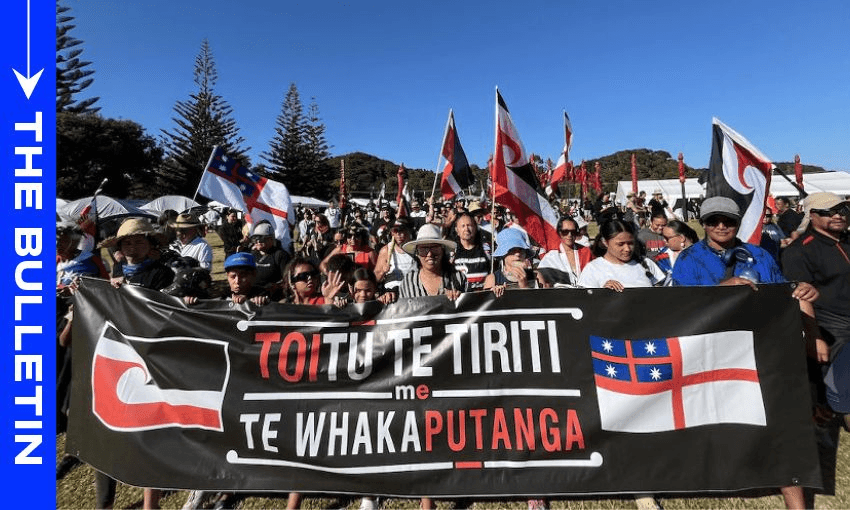By and large, everyone was able to speak in all manner of ways and do so uninhibited and safely at Waitangi. Whether everyone felt heard is up for debate, writes Anna Rawhiti-Connell in this excerpt from The Bulletin, The Spinoff’s morning news round-up. To receive The Bulletin in full each weekday, sign up here.
Split focus and split pōwhiri
Being at Waitangi over three days is hard to summarise. There are the vibes, the food and the family-friendly festivities on the road in and at Ti Tii Marae. There are the forum tents where big conversations are had. Then there’s the Upper Treaty grounds and Te Whare Rūnanga, where most of the political action, activism and commemoration is focused. Focus was split further this year, with separate pōwhiri for the opposition (Saturday), Kiingitanga and Te Pāti Māori (Sunday), and the government on Monday. Mad Chapman recapped Sunday’s events here, noting the anticipation and alignment ahead of the government’s arrival on Monday. Adam Dudding captures some of the action from the forum tent for The Post this morning. Chapman also liveblogged the government’s arrival and events yesterday if you need to catch up. RNZ’s photographers have some great shots from Monday and yesterday, as well.
The workings of a three-party coalition on display
As Stuff’s Tova O’Brien reported on Monday, the origin of the decision to have separate pōwhiris seems to be a bit muddy, with prime minister Christopher Luxon saying the Waitangi National Trust sets out protocol. Trust chairman Pita Tipene told Stuff he wasn’t sure “who led the request from government.” In a summary of Monday’s speeches from representatives of the government (dubbed the “three-headed taniwha” by some), O’Brien argues they revealed the divergence inherent in a three-party coalition. “That was them, exactly as they are, perfectly representing and talking to their individual policies and constituencies,” she writes. “Sure, they don’t tessellate but they fit. And after the enormous challenge they were presented with at Waitangi, they showed they can make it work.” The challenge to Act at Waitangi in response to its proposed Treaty Principles Bill seemed the most enormous. Act leader David Seymour was heckled and booed, while Act MP Nicole Mckee’s speech was cut short by waiata (as tikanga allows).
Luxon’s speech draws criticism
Many words have been spilled in reaction to Luxon’s speech from the marau (porch) of Te Whare Rūnanga on Monday, in which the prime minister steered clear of directly addressing concerns raised by other speakers. The Herald has compared the speech with his speech at Waitangi last year. Parts are identical. This year’s speech has been described as subdued, banal, dishwater dull, pedestrian and beige. There is precisely zero disagreement from reporters and commentators about that. There is divergence (a theme emerges) on whether it was politically astute. Chapman argues it was so boring it became insulting. “Thousands gathered at Waitangi this morning to voice their concerns directly to the new government. And the prime minister made it clear he wasn’t listening,” she writes. Newsroom’s Jo Moir writes that Luxon was “unable or unwilling to think on his feet and respond to the challenges laid down before him. O’Brien suggests the speech “landed about right and seemed the appropriate approach to take”, perhaps diffusing the tension that emerged after Seymour spoke. The Herald’s Simon Wilson agrees (paywalled) that it was insulting for Luxon not to acknowledge the outpouring of concern and that the prime minister didn’t rise to the occasion but that there might be something clever about it. “The hopeful way to look at the speech is that Luxon was signalling he will now shut down attempts by Act, NZ First and some of his own ministers to inflame the issues.” Speaking to Moir, National MP and Maori Affairs select committee Dan Bidiois said Luxon’s speech was deliberate. “There’s a saying from an old professor of mine, get off the dance floor and onto the balcony… I think the prime minister got on the balcony, got off the dance floor, out of the noise and actually tried to articulate a wider perspective of where we’re heading as a country.”
Many spoke but who was heard?
Wilson, continuing in a hopeful vein, writes this morning (paywalled) that “a decent chunk of the nation has come together. This is us.” As we left Waitangi yesterday, we were flagged down by a member of Te Hīkoi o Te Kotahitanga ki Waitangi. He politely told us horses were coming through as part of the hikoi and we joined a few dozen cars in slowing down as they did. It was a striking image to leave Waitangi with, rivalled for me only by the Tame Iti-led hikoi. The groups joined the thousands upon thousands who converged at Waitangi over four days to say something and be heard. By and large, everyone was able to speak in all manner of ways and do so uninhibited and safely. It’s a testament to the maanatikanga of the hosts, volunteers, and all involved. Whether everyone felt heard is up for debate. The final word goes to Tipene, who considered Luxon’s speech to be lacking in addressing the concerns of Māoridom, but accepted there had been “glacial” progress. He looks forward to further discussion.
More Waitangi reading:
- Carwyn Jones provides some much-needed context to an eight-page advertorial featuring Apirana Ngata’s 1922 explanation of Te Tiriti o Waitangi that ran last week.
- Morgan Godfery analyses the arguments in Ned Fletcher’s meticulously researched book, The English Text of the Treaty of Waitangi (originally published in 2022).
- The Spinoff’s Te Tiriti reading (and watching and listening) guide
